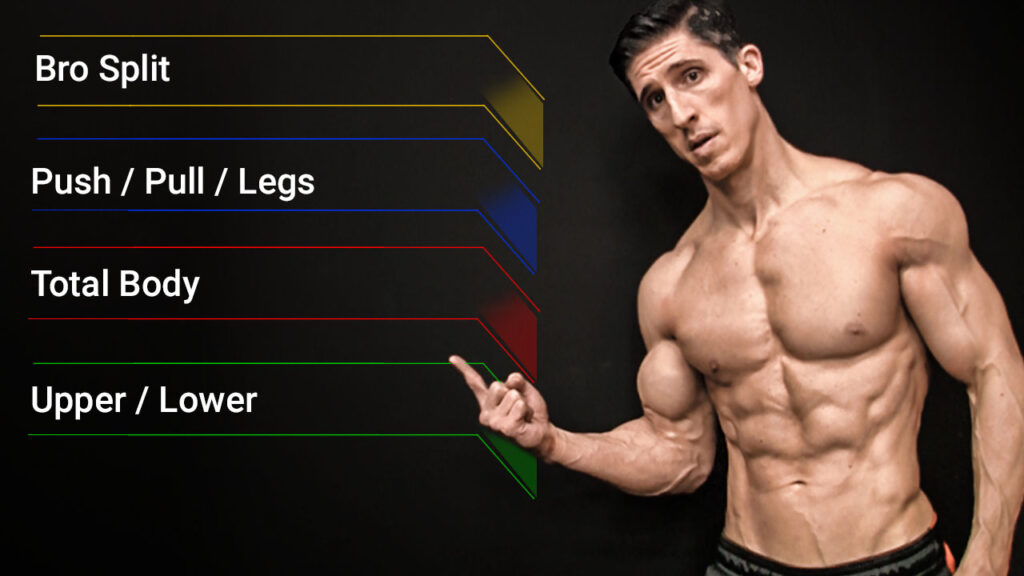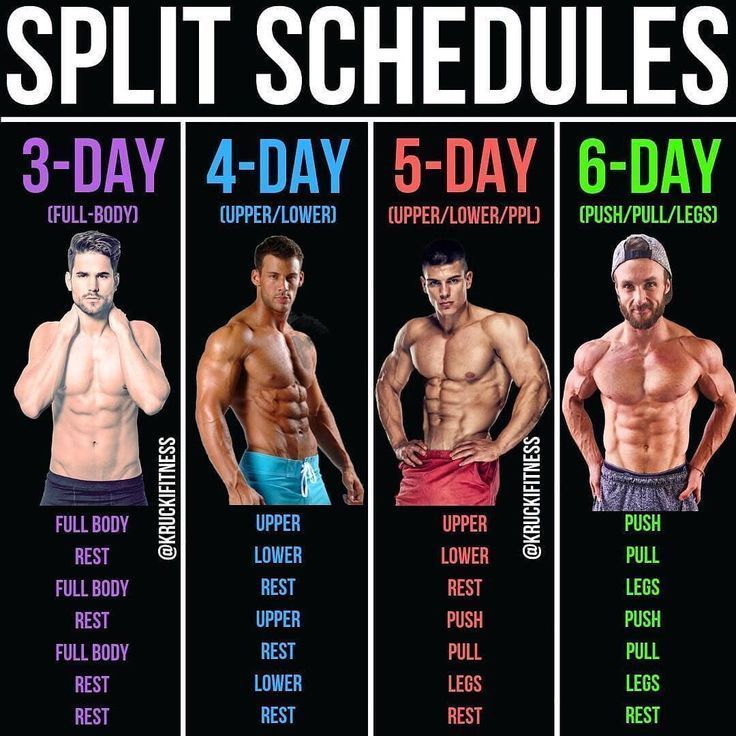Achieving optimal muscle growth is a complex interplay of factors including genetics, nutrition, recovery, and, crucially, training. A well-structured workout split forms the foundation of an effective muscle-building program. The “perfect” workout split, however, isn’t a one-size-fits-all solution. It’s a personalized approach tailored to individual factors like training experience, recovery capabilities, time availability, and specific muscle growth goals.
This comprehensive guide explores the concept of workout splits, dissects popular options, analyzes their pros and cons, and provides a framework for selecting the perfect split to maximize your muscle growth potential.

Understanding Workout Splits: The Foundation of Muscle Growth
A workout split is simply the way you organize your training week by dividing different muscle groups across different workout sessions. Instead of training your entire body every single workout, you split it up. This allows for:
- Targeted Muscle Stimulation: Each muscle group receives dedicated attention and volume, crucial for hypertrophy (muscle growth).
- Sufficient Recovery: Muscles require adequate recovery time after being trained. A split allows you to work on other muscle groups while the previously trained ones recover and rebuild.
- Increased Training Frequency: You can train each muscle group multiple times per week, optimizing muscle protein synthesis and growth signals.
- Improved Focus and Intensity: Concentrating on fewer muscle groups per workout allows you to maintain higher intensity and focus throughout the session.
Factors Influencing the “Perfect” Workout Split:
The ideal split is subjective and depends on several individual variables:
- Training Experience:
- Beginners: Typically benefit from full-body or upper/lower splits due to their ability to recover faster and their need to learn fundamental movement patterns.
- Intermediate Lifters: Can transition to more specialized splits like push/pull/legs or bro splits to increase training volume and intensity.
- Advanced Lifters: Often require highly specialized splits to overcome plateaus and target specific muscle weaknesses.
- Recovery Capabilities: Factors like sleep, nutrition, stress levels, and genetics significantly impact recovery. Those who recover faster can handle more frequent training and higher volume.
- Time Availability: The number of days you can commit to training per week dictates the feasibility of different splits. Some splits require more frequent gym visits than others.
- Specific Muscle Growth Goals: Prioritizing certain muscle groups will influence how frequently and intensely they are trained within the split.
- Personal Preference: Enjoyment is crucial for adherence. Choose a split you find motivating and sustainable.

Popular Workout Splits: Analysis, Pros, and Cons
Here’s a breakdown of common workout splits, evaluating their suitability for different individuals:
1. Full Body Split:
- Description: Training all major muscle groups in each workout session. Typically performed 3 times per week, with rest days in between.
- Example:
- Monday: Squats, Bench Press, Rows, Overhead Press, Deadlifts, Bicep Curls, Triceps Extensions.
- Wednesday: Repeat Monday’s workout or slightly vary the exercises.
- Friday: Repeat Monday’s workout or slightly vary the exercises.
- Pros:
- Suitable for Beginners: Easy to learn fundamental movements and build a solid foundation.
- Frequent Muscle Stimulation: Each muscle group is stimulated multiple times per week.
- Time-Efficient: Requires only 3 workouts per week.
- Promotes Overall Strength and Conditioning: Engages multiple muscle groups simultaneously.
- Cons:
- Can Be Taxing: Requires significant overall energy and can be challenging for recovery, especially for advanced lifters.
- Limited Volume per Muscle Group: May not provide sufficient stimulus for advanced muscle growth.
- Not Ideal for Specialization: Difficult to prioritize specific muscle groups.
2. Upper/Lower Split:
- Description: Dividing workouts into “Upper Body” and “Lower Body” days. Typically performed 4 times per week, alternating upper and lower days with rest days.
- Example:
- Monday: Upper Body (Chest, Back, Shoulders, Biceps, Triceps)
- Tuesday: Lower Body (Quads, Hamstrings, Glutes, Calves)
- Wednesday: Rest
- Thursday: Upper Body
- Friday: Lower Body
- Saturday: Rest
- Sunday: Rest
- Pros:
- Balanced Approach: Allows for focused training of both upper and lower body.
- Increased Volume per Muscle Group: More volume can be dedicated to each muscle group compared to a full-body split.
- Suitable for Intermediate Lifters: Provides a good balance between frequency and volume.
- Cons:
- Requires More Gym Time: Involves 4 workouts per week.
- Still Limited Specialization: Doesn’t allow for highly specific muscle group targeting.
- Potential for Upper/Lower Imbalance: Requires careful exercise selection to ensure balanced development.
3. Push/Pull/Legs (PPL) Split:
- Description: Dividing workouts into “Push” (chest, shoulders, triceps), “Pull” (back, biceps), and “Legs” (quads, hamstrings, glutes, calves) days. Can be performed 3, 4, 5, or 6 days per week.
- Example (6-Day PPL):
- Monday: Push
- Tuesday: Pull
- Wednesday: Legs
- Thursday: Rest
- Friday: Push
- Saturday: Pull
- Sunday: Legs
- Pros:
- Efficient Muscle Group Grouping: Logically groups muscles that work together.
- High Volume Potential: Allows for significant volume per muscle group.
- Suitable for Intermediate to Advanced Lifters: Can be adjusted to accommodate different training goals and recovery capabilities.
- Flexible Scheduling: Can be adapted to different training frequencies.
- Cons:
- Requires Careful Planning: Exercise selection is crucial to avoid overworking certain muscles.
- Can Be Demanding on Joints: Requires proper warm-up and cool-down to minimize joint stress.
- Potential for Overtraining: Requires attention to recovery and deloading.
4. Bro Split (Muscle Group Isolation Split):
- Description: Dedicating each workout to a single muscle group. Typically performed 5-6 days per week, with each muscle group trained once per week.
- Example:
- Monday: Chest
- Tuesday: Back
- Wednesday: Shoulders
- Thursday: Legs
- Friday: Arms (Biceps and Triceps)
- Saturday: Rest
- Sunday: Rest or Repeat a Muscle Group.
- Pros:
- High Volume per Muscle Group: Allows for maximum volume and focus on each individual muscle.
- Good for Addressing Weaknesses: Can be used to prioritize specific muscle groups.
- Potentially Easier Mentally: Focusing on one muscle group can feel less overwhelming.
- Cons:
- Low Training Frequency: Each muscle group is only trained once per week, potentially limiting growth potential.
- Not Ideal for Beginners: Requires a strong foundation of strength and experience.
- Can Lead to Overtraining of Supporting Muscles: Isolating muscles can neglect the importance of compound movements and overall strength.
- Potentially Less Efficient: Focusing only on isolation exercises may not be the most efficient use of training time.
5. Hybrid Splits:
- Description: Combining elements of different splits to create a customized training program. For example, combining push/pull/legs with a full-body day.
- Example:
- Monday: Push
- Tuesday: Pull
- Wednesday: Legs
- Thursday: Full Body (Focus on compound movements)
- Friday: Rest
- Saturday: Push
- Sunday: Pull
- Pros:
- Highly Customizable: Can be tailored to individual needs and goals.
- Addresses Specific Weaknesses: Allows for targeted training of lagging muscle groups.
- Combines Benefits of Different Splits: Can incorporate both frequency and volume.
- Cons:
- Requires Advanced Knowledge: Requires a thorough understanding of training principles and exercise selection.
- Potential for Overcomplication: Can be difficult to design and manage.
- Requires Careful Monitoring: Requires close attention to recovery and potential for overtraining.

Choosing the Perfect Workout Split: A Step-by-Step Guide
Follow these steps to select the optimal workout split for your needs:
- Assess Your Training Experience: Are you a beginner, intermediate, or advanced lifter?
- Evaluate Your Recovery Capabilities: Consider your sleep, nutrition, stress levels, and genetics.
- Determine Your Time Availability: How many days per week can you realistically commit to training?
- Define Your Specific Muscle Growth Goals: Are you focused on overall muscle growth or prioritizing specific muscle groups?
- Consider Your Personal Preferences: Choose a split you find motivating and sustainable.
- Experiment and Adjust: Try different splits and track your progress. Adjust as needed based on your results and how your body responds.
- Prioritize Compound Exercises: Regardless of the split you choose, focus on compound exercises like squats, deadlifts, bench press, and rows.
- Incorporate Progressive Overload: Gradually increase the weight, reps, or sets you perform over time.
- Ensure Adequate Rest and Recovery: Prioritize sleep, nutrition, and stress management.
- Consider Deloading: Periodically reduce your training volume and intensity to allow your body to recover and prevent overtraining.

The Importance of Progressive Overload and Nutrition:
While the workout split is crucial, it’s only one piece of the puzzle. Progressive overload (gradually increasing the demands placed on your muscles) is essential for continued muscle growth. You can achieve progressive overload by:
- Increasing Weight: Lifting heavier weights.
- Increasing Reps: Performing more repetitions with the same weight.
- Increasing Sets: Performing more sets of the same exercise.
- Decreasing Rest Time: Reducing the rest time between sets.
- Improving Exercise Technique: Performing exercises with greater efficiency and control.
Nutrition is equally critical. To build muscle, you need to consume enough calories and protein. Aim for:
- Caloric Surplus: Consuming slightly more calories than you burn.
- Adequate Protein Intake: Aim for 0.8-1 gram of protein per pound of body weight.
- Balanced Macronutrient Ratio: Focus on a balanced intake of carbohydrates, fats, and protein.

How To Train For Pure Muscle Growth
Conclusion: The “Perfect” Split is the One That Works for YOU
Ultimately, the “perfect” workout split is the one that aligns with your individual circumstances, goals, and preferences. There’s no magic formula, and what works for one person may not work for another. Experiment with different splits, track your progress, and adjust as needed. By understanding the principles of workout splits and listening to your body, you can find the optimal training program to maximize your muscle growth potential. Remember that consistency, progressive overload, and proper nutrition are equally important for achieving your fitness goals.
FAQ
Which split is best for muscle growth?
What is cbums workout split?
What is the fastest split to build muscle?
How to build muscle fast?
Maximize your workout time with compound exercises. Some exercises only focus on specific muscles in your body. …
Go for high-intensity workouts. …
Make sure you’re eating enough. …
Get enough rest. …
Try supplements. …
Make a goal to train each muscle two to three times per week.